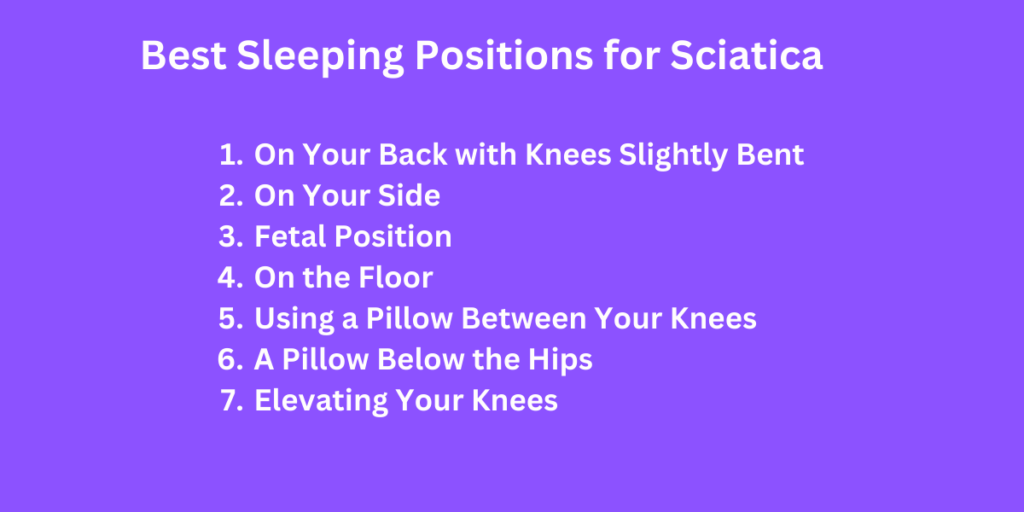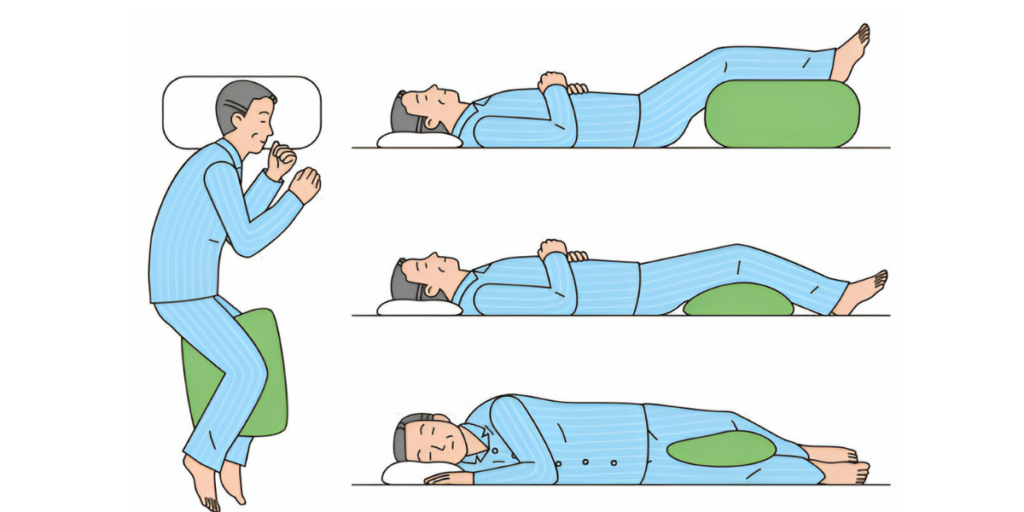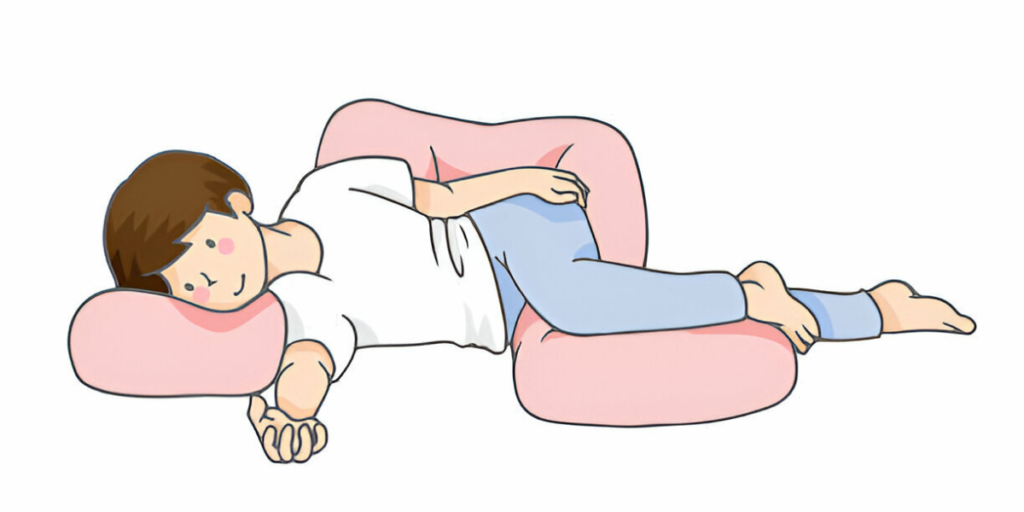
How to Sleep with Sciatica (7 Best Sleeping Positions)
Dealing with sciatica can be challenging, especially when trying to sleep. Sciatica, characterized by pain radiating from the lower back down the legs, often intensifies at night, making comfortable sleep difficult.
Many patients at my Melbourne CBD and Prahran chiropractic clinics ask for advice on how to sleep with sciatica.
Understanding why sciatica pain worsens at night is key to finding relief. During the day, movement helps reduce pressure on the sciatic nerve.
When lying down, this pressure can increase, worsening the pain. Additionally, the body’s natural inflammation response is more pronounced at night, adding to discomfort.
I recommend several sleeping positions to help alleviate sciatica pain. Placing a pillow between or beneath your knees can improve spinal alignment.
Sleeping on the floor can sometimes relieve symptoms, and the fetal position is another effective option. Using a pillow between your legs can also help align the hips, pelvis, and spine.
To reduce sciatica pain before bed, consider gentle stretches, taking a warm bath, and practicing yoga. Ensure your mattress is firm, or add plywood for support.
Strategically placing pillows and establishing a relaxing nighttime routine can also enhance sleep quality.
Sleeping with sciatica during pregnancy is particularly challenging. Try using a pregnancy pillow, sleeping on your left side, elevating your legs, and doing gentle stretches before bed.
By implementing these strategies, you can achieve a more restful and pain-free sleep, ultimately improving your overall quality of life.
What are the Best Sleeping Positions for Sciatica?

Finding the right sleeping position can significantly reduce sciatica pain and help you get a better night’s sleep with sciatica. Here are some of the best sleeping positions for alleviating sciatica discomfort:
1. On Your Back with Knees Slightly Bent
Sleeping on your back with your knees slightly bent can help relieve pressure on the sciatic nerve. Place a pillow under your knees to maintain a natural curve in your lower back and reduce stress on the spine.
2. On Your Side
Sleeping on your side can alleviate sciatica pain, especially if you place a pillow between your knees. This position helps keep your spine aligned and reduces pressure on the lower back and sciatic nerve.
3. Fetal Position

Curling up in the fetal position can create space between the vertebrae, relieving tension on the sciatic nerve. Make sure to use a supportive pillow for your head and neck to maintain proper alignment.
4. On the Floor

Sleeping on a firmer surface, like the floor, can provide better support for your spine. If you find a hard surface uncomfortable, try placing a thin mattress or mat on the floor to add some cushioning.
5. Using a Pillow Between Your Knees

When sleeping on your side, placing a pillow between your knees helps keep your hips, pelvis, and spine aligned, reducing strain on the sciatic nerve.
6. A Pillow Below the Hips
If you prefer sleeping on your stomach, placing a pillow under your hips can help maintain the natural curve of your spine and reduce pressure on the lower back.
7. Elevating Your Knees
When sleeping on your back, elevate your knees by placing pillows or a cushion under them. This position helps reduce pressure on the lower back and can alleviate sciatica pain.
Experiment with these positions to find the one that offers the most relief for your sciatica symptoms. Adjusting your sleeping position can make a significant difference in managing pain and improving sleep quality.
How Can You Reduce Sciatica Pain Before Bed?

Reducing sciatica pain before bed involves a combination of pre-sleep activities and adjustments to your sleep environment. Here are several strategies to help you minimize discomfort and improve your sleep quality:
1. Gentle Stretches Before Bed
Performing gentle stretches can help relax your muscles and reduce tension around the sciatic nerve. Focus on stretches that target the lower back, hips, and legs. Examples include knee-to-chest stretches, piriformis stretches, and seated spinal twists.
2. Take a Warm Bath
A warm bath can help relax your muscles and reduce inflammation, providing temporary relief from sciatica pain. Soaking in warm water for 15-20 minutes before bed can help you unwind and prepare for a restful night’s sleep.
3. Do Yoga
Adding yoga into your nighttime routine can help stretch and strengthen muscles, improve flexibility, and reduce sciatica pain. Gentle yoga poses like Child’s Pose, Cat-Cow Stretch, and Pigeon Pose can be particularly beneficial.
4. Avoid Soft Mattresses
A firm mattress provides better support for your spine and helps maintain proper alignment. Avoid soft mattresses that can cause your body to sink and increase pressure on the sciatic nerve. If a new mattress isn’t an option, try placing a piece of plywood under your existing mattress to add firmness.
5. Get a Piece of Plywood
Placing a piece of plywood between your mattress and box spring can provide additional support, preventing your mattress from sagging and improving spinal alignment.
6. Use a Body Pillow

A body pillow can help you maintain a comfortable sleeping position and provide support for your spine, hips, and legs. It can be especially helpful for side sleepers to keep their spine aligned.
7. Visit a Chiropractor
Seeing a chiropractor can help address the underlying causes of sciatica. Chiropractic adjustments, spinal decompression, and other treatments can reduce pain and improve your overall spinal health.
By including these strategies into your nighttime routine and making adjustments to your sleep environment, you can reduce sciatica pain and improve your overall sleep quality,
How to Sleep with Sciatica During Pregnancy.

Sleeping with sciatica during pregnancy can be especially challenging due to additional weight and changes in body alignment. Here are a few tips to help:
- Use a Pregnancy Pillow: A full-body pregnancy pillow can support your back, belly, and legs, helping to keep your spine aligned.
- Sleep on Your Left Side: This position can improve blood flow and reduce pressure on the sciatic nerve.
- Elevate Your Legs: Placing a pillow under your legs can help relieve pressure on your lower back and hips.
- Gentle Stretches: Perform gentle stretches before bed to relax your muscles and ease tension.
How Chiropractic Can Help You Sleep with Sciatica
As a leading chiropractor in Melbourne, I offer non-invasive treatment options for sciatica pain relief to enhance your overall well-being and sleep quality.
Chiropractic care at Flynn Chiro, targets spinal misalignments and nerve compression, providing effective pain relief and promoting long-term recovery.
Personalized treatments include ergonomic advice and therapeutic exercises designed to reduce tension and support better sleep.
Visit us for discovering how chiropractic care alleviates sciatica symptoms and enhances daily life.

Flynn Pettersson
I am committed to providing exceptional chiropractic care in Melbourne, focused on your health and well-being.

Flynn Pettersson
I am committed to providing exceptional chiropractic care in Melbourne, focused on your health and well-being.






